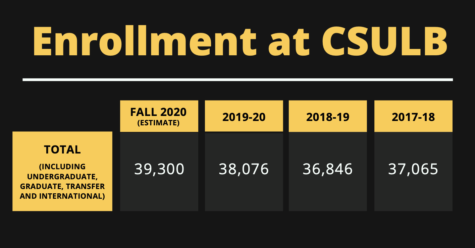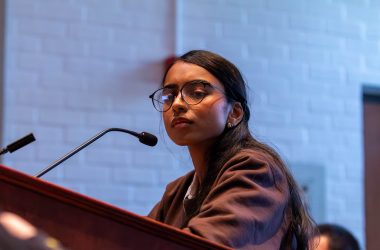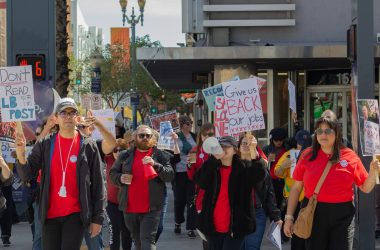Despite instruction being mainly online, enrollment at Long Beach State has reached an all-time high for the fall 2020 semester with close to 39,300 students, about 1,000 more than last year.
According to Timothy Gotimer, communications specialist for enrollment services, CSULB admitted about 4,800 incoming freshmen, 5,100 transfer students, 1,600 graduate students and an additional 600 post-bachelor students, which is a “historic high.”
President Jane Close Conoley said the university has been growing in enrollment applications since 2014 and feels pleased with the Beach’s rise in students.
“I am delighted. I want us to be accessible to students who are willing to do the hard work of a Beach degree,” Conoley said. “I think we’ve grown as a reputation for excellent teaching. Basically, we are awesome.”
According to Dhushy Sathianathan, vice provost of academic planning, the increase in enrollment this semester is primarily due to an increase in transfer applicants and continuing students, particularly local students who prefer to stay closer to home.
He said it is likely students are “taking advantage” of online instruction to take more courses than they normally would.
“There is a clear indication that local transfer students have preferred to stay closer to home than transfer to northern campuses,” Sathianathan said. “CSULB is committed to increasing access [and] I am delighted we can provide opportunities for students.”
Sathianathan said that although new non-resident enrollment is 50% lower than fall of 2019, this is only 3% of incoming students, meaning “a decline in non-resident enrollment does not significantly impact the overall campus enrollment.”

International student enrollment is lower by about 29%, according to Gregory Woods, director of news media services, which is likely due to travel restrictions imposed by the coronavirus pandemic. This fall, CSULB has a total of 274 new international students, while the university had 387 newly enrolled international students last fall.
“The reputation of a Beach education remains strong and is a pathway to career goals, further education and social mobility,” said Jeff Cook, vice president of strategic communications. “This has not changed during the pandemic and our largely virtual environment.”
Conoley said she feels enrollment may have reached record-high numbers this fall due to assumptions that students would not want to attend a mainly virtual semester. Also, with fewer students on campus, the traditionally difficult parking situation is no longer an issue for many commuters.
“We may have reached a bit into our wait list during the time when everyone was predicting that fewer students would come for a remote semester,” Conoley said.
Conoley said she doesn’t feel that enrollment will continue to rise, though, as the university receives an enrollment cap by the state of California.
CSULB’s cap, set by the chancellor’s office, is at 30,975 full-time-equivalent students, while the university is currently projecting 32,586 full-time-equivalent students, according to Sathianathan. This is roughly within 5% of the target enrollment, he said.
The 30,000-student cap differs from the actual headcount of about 39,300 enrolled students, as some CSULB students are not full-time students.
“The state pays for about half of instruction,” Conoley said. “If we go over the cap, we get just tuition and no state funding for students.”
With enrollment at a historic high, CSULB has additional revenue from tuition this semester.
Much of this revenue, Conoley said, is likely going toward paying faculty salaries, which remain unchanged regardless of the mode of instruction. She also said some of the revenue will be used to fund required medical and retirement costs that have increased.
The higher enrollment has also brought higher instructional costs, though.
Sathianathan said he feels the additional revenue “does not come close to mitigating these challenges” and that the university is using one-time reserves to offer essential courses and services.
To prepare for the coming years, Conoley said CSULB will use 50% of its reserve funds for the 2020-21 academic year.
“Of course, it won’t make up for a $20 million cut, but it’s good news,” Conoley said. “If we don’t get state support and tuition, we’re in trouble.”
Announced in July, CSULB received a budget cut of $22 million this academic year, and this budget challenge will continue for several years, according to Sathianathan.
“The next few years are expected to be far more challenging,” he said.
Conoley said CSULB will cut back on hiring and travel to help reduce spending.
“There’s no doubt that we’re in for a bumpy ride,” Conoley said.





Pingback: CSU reaches record-high enrollment, graduation rates across system - Daily Forty-Niner